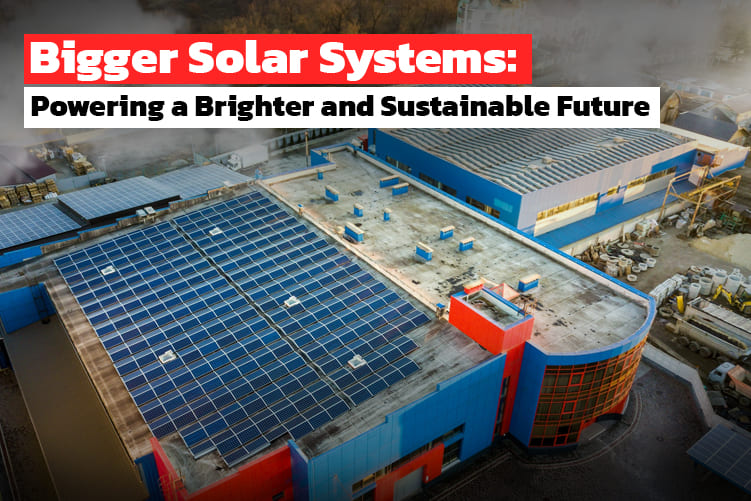In the ever-evolving landscape of energy production and consumption, the choices we make today can significantly impact our future. One such choice that has gained momentum over the years is utilizing the power of the sun through solar energy. With Australia’s solar landscape constantly evolving, it’s crucial to understand why going bigger with your solar system is not just a choice but a smart investment for the future.
The Solar Evolution: A Decade of Change
Ten years ago, in 2013, the average solar system size installed in Australia was a modest 4kW. Fast forward to 2023, and that figure has more than doubled, reaching an impressive 9.3 kW. This remarkable growth reflects several key factors that have reshaped the solar energy landscape over the past decade.
Advances in Solar Technology
The solar industry has witnessed remarkable technological advancements over the years. Solar Module wattage has increased significantly, allowing for greater energy generation from the same amount of space. In 2013, the average solar panel had a wattage of around 230W. Today, that number has soared to an impressive 440W. This nearly doubling of solar output within the same roof space is a testament to the relentless pursuit of efficiency in solar technology.
Power-Hungry Homes
Modern homes have become increasingly power-hungry due to the electrification revolution sweeping across Australia. Electrification involves transitioning away from gas and other fossil fuels towards electricity, exemplified by the adoption of electric vehicles (EVs), induction cooktops, and electric appliances. With these changes, homes are projected to consume more electricity than ever before.
The Coming Tide of Change
As Australia transforms towards electrification, our homes will rely more on the electrical grid. Presently, the average daily home electricity usage stands at 18kWh. However, experts anticipate that this consumption will double, if not more, as gas and petrol vehicles are phased out and new electric devices are introduced. Therefore, it’s essential to prepare for this shift by increasing your home’s solar capacity.
The Importance of Solar System Size
Let’s break down why the size of your solar system matters. A 4kW system, for instance, would generate an average of 16kWh of electricity per day. However, this may not suffice for a single-person household, which consumes 8-12kWh per day on average. Imagine the energy needs of a multi-person household, which can range from 20 to 30kWh per day. In this scenario, a 9kW system, producing around 32kWh per day, becomes more fitting.
It’s crucial to note that solar panels generate electricity during daylight hours, while peak electricity usage typically occurs between 4pm and 8pm. Since feed-in tariffs are minimal, any surplus electricity sent to the grid may not significantly impact your bills. This prompts a critical question: how can we maximize our solar investment and future-proof our homes?
Transforming Your Home into a Power Plant
The ultimate goal for homeowners should be achieving energy independence. To do so, maximizing every square centimeter of roof space is vital. Thanks to higher wattage panels, it’s now possible to generate more energy from the same roof area. In the past, a roof might have accommodated a 6kW system, but with modern panels, it can support a 10kW system.
When deciding on your solar system size, consider your future energy needs. Will you be adding an EV, upgrading appliances to electric, or switching to electric gardening tools? Anticipating your electricity usage patterns is essential for a well-sized solar system.
The Role of Battery Storage
While solar panels generate electricity during the day, you’ll need a way to store that energy for night-time use. This is where battery storage comes into play. Although battery systems can be expensive, ranging from $5,000 to $20,000, they offer substantial long-term benefits.
Solar batteries capture and store daylight-generated energy for use at night or during power outages, giving you full control over your energy usage. With a solar battery, you can bid farewell to electricity bill anxiety, as fluctuations in the energy market will have minimal impact on your energy costs.
Avoiding Expensive Upgrades
One compelling reason to maximize your solar system now is to avoid the inevitable costs of upgrading or replacing an undersized system in the future. Solar panels have a life expectancy of 25 years or more, but many systems end up in landfill prematurely due to the need for larger capacity.
When installing solar, consider your current and future energy habits. Adjust your usage times to coincide with daylight hours whenever possible, and assess how your energy needs may change over time. This proactive approach ensures that your solar system aligns with your long-term requirements.
The Bottom Line
Solar decisions often hinge on budget considerations, but financing options and government incentives make going bigger more accessible than ever before. Notably, the average price of a 5kW solar system in 2013 is equivalent to the cost of a 10kW system in 2023, making this the opportune moment to reap the benefits of solar energy.
As Australia strives to achieve its net-zero targets, solar power remains a critical component of the journey. Solar Miner is one of the most preferred solar retailers in Victoria offering premium Tier 1 solar options with solar battery. Reach out to our experts at 1300285885 to get a free solar quote for your property.






